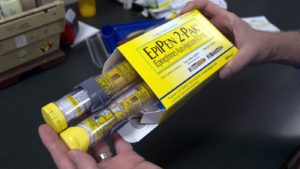Life-threatening allergic reactions (anaphylaxis) are an issue for up to 2% of the US population, leading to as many as 1,500 deaths each year (see here). These severe reactions can be caused by a number of severe allergens for some, like peanuts, shrimp, bee stings and latex exposure. The primary treatment for anaphylaxis is epinephrine, a stress hormone produced in the human adrenal gland, which has been synthesized in labs and pharmaceuticalized for decades. It can be given intravenously in a critical care setting, but given the sudden onset of anaphylaxis and the immediate need for rescue, epinephrine has been formulated and packaged in an individual-dose, self-administered injector which can be carried by susceptible persons and self-injected. In recent years, the cost of an EpiPen (the leading brand name for the epinephrine injector) has been under $100 USD. In the past year, the list price for a two-pen package has risen to over $600. This has sparked public outrage, calls for more government regulation of the pharmaceutical industry, criticism of the EpiPen corporation’s (Mylan) CEO who makes $18M/year, and caused great concern that life-saving drugs might not be available for those that can’t afford this extreme price.
Zerohedge.com is one of my daily go-to sites, and recently posted a nice starter article on the political connections, donations and lobbying networks that complicate this particular situation, as well as the corporo-government medical cabal, at large:
As Congress Prepares To Crackdown On Epipen Price Increases, A Problem Has Emerged
I shared this on social media as an initial commentary:
“It doesn’t matter if Mylan charges $1M per dose. What makes this an idiotic situation is that the FDA and Gov Regulations have driven out of business all competitors for an injectable drug that has been around for decades. That’s what Gov does. It creates monopolies. That is the main outcome of regulation – it kills off everybody until only the Big Corporations are left standing, who can afford to lobby the politicians to their favor and pay for the heavy compliances.”
Today, as the media fury mounts, zerohedge ran another nice summary article and an embedded CNBC interview with the Mylan CEO, Heather Bresch. Despite the public’s understandable desire to hold the corporate exec personally and soley responsible for the ridiculous price increases, she appropriately deflects some of the blame and demonstrates at least a partial grasp that she is not alone as a causative agent of what could be termed “price gouging.” The very distorted health care services and pharmaceutical market is an outcome of innumerable entities, all of which operate outside of a transparent and free market economy.
Again, to share my social media response to the article and interview:
“Aside from the monopolism provided to Mylan by Gov, aside from the pricing hidden from consumers and doctors by Gov and corporations, aside from the many inefficient and costly intermediary bodies that interpose and parasitize the interaction between the consumer/patient and the end service of doctor or drug company, THIS is what you get when you legislate and politicize an economy. YOU created this. YOU vote for this. When you want subsidies and protections and regulations and mandates and taxes,… THIS is what you get.
“Instead, you might consider rejecting the idea that you can get something for nothing. Consider a direct interaction with a physician that will give you an honest and transparent price without all of the interlopers and secrecy. Consider permitting free markets and competition so that multiple options abound for the drugs and services that you will ultimately pay for… whether you know you’re paying for it or you pay for it surreptitiously by the taxes stolen from you and used in asinine ways.
“The CEO is certainly correct about one thing: consumers are paying TWICE now with Obamacare: premiums and deductibles have skyrocketed, so you’re getting soaked by the insurance corporations, AND you’re paying full retail price for services and drugs that fall below the threshold of your rising deductibles – which may be into the thousands of dollars. You THOUGHT you were voting for reduced prices, increased access, free services. Per usual, your vote turned to sh*t and you got the opposite of your expectations because you made the same mistake you always make – you trusted Gov and politicians to make your life better. You never learn.”
And additionally,
“The CEO points out that the ‘System’ incentivizes companies to raise prices. That is absolutely true. Every embedded and interjected contract between the service provider along the way to the consumer – insurance corporation, distributor, retailer, hospital, administrators, sales, whatever – each wants a ‘discounted’ price far below the ‘list price.’ The service provider cannot set a normal price in order to have a decent profit margin. That list price will be used as the starting point in contract negotiations from which the interloping parties will demand a 10%, 20%, 70% reduction in price as part of the contract. Prices must be started high, knowing that the final revenue recovered will be fractional. That is a basic negotiation tactic and has now been legislated into the System by decades of corporo-gov collusion. The end consumer (patient) cannot be simply given a good price, because that would then become the ‘customary’ fee from which the negotiations would be based.
“Solution? More gov, more law, more regulation? How about removing all of that, since those are the very causes of the distorted economy and pricing mechanisms in the first place.”
An additional thought as I write this: “where is (or what happened to) the competition?” Wikipedia points out that the FDA has denied approval for Teva’s formulation of an epinephrine autoinjector, and Sanofi’s product has been recalled. As of 2015, Mylan had an 85% market share of the autoinjector market, and perhaps that is even higher today. I’ll keep looking into this, especially the role of FDA restrictions, and share findings in the comments. For a drug that’s been around for decades, that costs less than $1 in its generic, intravenous vial form (that I use in the operating room), it makes little sense that open markets could create an environment in which a $600 formula becomes the only option available… because free markets are not to blame.
M. Todd Rice, MD – board-certified anesthesiologist, free market advocate, consumer, parent, corporo-gov skeptic, lifetime student, all-around nice guy.


Don’t Blame Capitalism for Your Pricey EpiPen – Foundation for Economic Education
https://fee.org/articles/don-t-blame-capitalism-for-your-pricey-epipen/?utm_source=zapier&utm_medium=facebook
The Lack of EpiPen Competitors is the FDA’s Fault – The Mises Institute
https://mises.org/blog/lack-epipen-competitors-fdas-fault